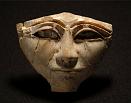 |
| in Syria |
|
Español | عربي |
Introduction: Qatna, modernly known as Al Mishrifeh, is an ancient city in Syria, present day Tell-el-Mishrifeh in the Wadi il-Aswad, a tributary of the Orontes, 18 km northeast of Homs. The tell occupies 1 km², which makes it one of the biggest bronze Age towns in central Syria. The tell is located at the edge of the limestone-plateau of the Syrian desert towards the fertile Homs-Bassin History Al Mishrifeh or Qatna was founded around 2700/2600 BC during the Early Bronze Age III on a limestone plateau. The first occupation of the site is distinguished by the presence of dwellings equipped with storage and other domestic installations such as fireplaces. The first finds in Qatna date to the third dynasty of Ur. The find of an Egyptian sphinx belonging to Princess Ita, daughter of Amenemhat II (1875 - 1840 BC, 12th dynasty) shows early Egyptian influence, although it is not clear at what time the sphinx got to Qatna (the sphinx was found within the debris of the Late Bronze Age palace). The first king of Qatna (Qatanum) known by name from the Mari archives is Ishi-Addu (Adda is my help), an Amurru. He was a confederate of Shamshi-Addu of upper Mesopotamia. He was succeeded by his son Amut-pî-el who had been governor of Nazala as crown prince. This was in the time of Hammurabi of Babylon (1792-1750). Beltum, the sister of Amut-pî-el was married to Jasmah-Addu of Mari. Contracts between Mari and Qatna define her as the principal wife of Jasmah-Addu. Her mother might have been Lammassi-Ashur from Assur or Ekallatum. Zimrilim of Mari was married to another princess from Qatna, Dam-hurasim. After the destruction of Mari by Hammurapi, the written sources become sparse. Aleppo (Yamkhad) now became Qatna's most powerful neighbour, during the reign of Jarim–Lim III. Qatna was temporarily dominated by Aleppo. With the development of the Mitanni empire in upper Mesopotamia, Qatna was incorporated but was located in disputed territory between the Mitanni and Egypt. The inscriptions of the so-called Nin-Egal temple (part of the Royal palace, room C) show that Mittanni were resident in Qatna. The campaigns of Pharaohs Amenhotep I (1515-1494) and Thutmose I (1494-1482) in Syria might have reached Qatna, but there is no conclusive evidence. On the 7th Pylon of the temple of Amun in Karnak, Thutmose III (1479-1425 BC) mentions that he stayed in the land of Qatna in the 33rd year of his reign. Amenhotep II (1427-1401) was attacked by the host of Qatna while crossing the Orontes, but of course he remained victorious and acquired booty, among which the equipment of a Mitanni charioteer is mentioned. Qatna is mentioned in Egyptian topographic lists till the time of Ramesses III (1180 BC). Cuneiform tablets discovered under the Royal palace in Qatna mention a previously unknown king Idanda who ruled ca. 1400 BC. During the Syrian campaign of the Hittite king Suppiluliuma I (1380-1340), Prince Akizzi of Qatna asked for the help of Akhenaten/Amenhotep IV, but as he was only concerned with his monotheistic reform symbolized by his own thone name Akhnaton and his new capital Amarna (abandoned after his death as all reforms were reversed), the town was among several Syrian city-states captured and plundered by the Hittites, the inhabitants deported to Hatti. During this same Amarna letters period, Prince Akizzi wrote 5 letters to Akhenaten. Texts from Emar describe how Qatna was attacked by Aramaic tribes in the late Bronze Age, so the town must still have been in existence. The tell was settled in Neo-Babylonian times as well (a hilani has been excavated), but the town remained insignificant as nearby Homs (Emesa) had taken over its position on the trade routes. |
||||||||||||||||||||||||||||||||||||||||||||||||||
|
||||||||||||||||||||||||||||||||||||||||||||||||||
|
|
|
|

Custom Search
|
| © Copyright Homsonline.com |
| |
||
| |
|
|





